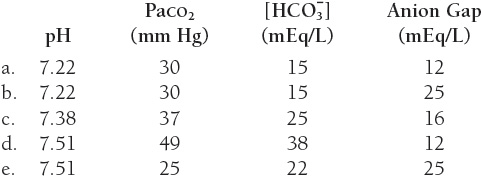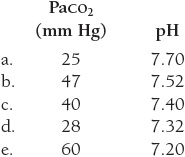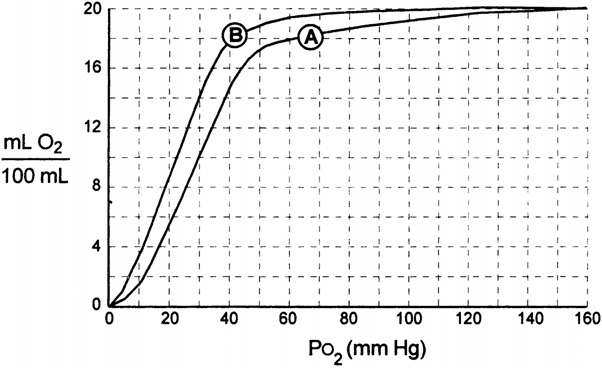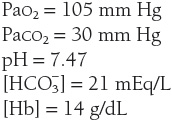The infant is treated for gastroenteritis and a saline drip is started. After 3 days, he appears well and alert and his diarrhea and vomiting have subsided. However, he still has hypernatremia, polyuria, and low urine sodium. These persistent clinical signs are most likely due to which of the following?
a. Diabetes insipidus
b. Diabetes mellitus
c. Hypothyroidism
d. Hyperaldosteronism
e. Renal failure
19. A 65-year-old man being treated with a beta-blocker and an angiotensin-converting enzyme (ACE) inhibitor for his heart failure presents to his cardiologist’s office complaining of fatigue, weakness, shortness of breath, and an irregular heartbeat. An electrocardiogram (ECG) reveals atrial fibrillation, so his cardiologist adds digoxin to his treatment regimen, but tells the patient that he will need to get his blood drawn to check for low K+ on a regular basis. Hypokalemia will increase the risk and severity of digitalis toxicity because of which of the following?
a. Hypopolarization of cardiac muscle membranes
b. Increased amplitude of cardiac muscle action potentials
c. Increased excitability of cardiac muscle cells
d. Increased inhibition of the Na+ − K+ pump
e. Increased removal of cardiac cytosolic Ca2+ via the Na+ − Ca2+ exchanger
20. A man calls 911 after finding his 19-year-old son in a comatose condition. A blood sample drawn in the emergency department shows the following results:

Which of the following is the most likely diagnosis?
a. Carbon monoxide poisoning
b. Diabetes mellitus
c. Ethylene glycol ingestion
d. Renal tubular acidosis
e. Respiratory arrest
21. A 55-year-old obese man with type 2 diabetes mellitus presents for his annual checkup. Serum lipoprotein analysis done after a 12-hour fast shows elevated low-density lipoprotein (LDL) and very low-density lipoproteins (VLDL), elevated triglycerides, and decreased high-density lipo-protein cholesterol. What contributes to the lipid abnormalities in type 2 diabetes mellitus?
a. Hyperglycemia increases triglyceride uptake into adipose tissue.
b. Insulin resistance increases triglyceride uptake into adipose tissue.
c. Insulin resistance and hyperglycemia decrease fatty acid flux to the liver and lipolysis.
d. Insufficient insulin action in adipose tissue decreases lipoprotein lipase activity.
e. Insufficient insulin action increases LDL receptor activity.
22. A 72-year-old woman with a history of hypertension presents to the emergency department with generalized weakness. Her medications include a potassium-sparing diuretic and an ACE inhibitor. Serum creatinine and BUN are elevated. The ECG is shown below. Which of the following electrolyte disturbances should be corrected to have the ECG return to normal?

(Reproduced, with permission, from Knoop KJ, Stack LB, Storrow AB, Thurman RJ. The Atlas of Emergency Medicine. 3rd ed. http://www.accessmedicine.com. Copyright © The McGraw-Hill Companies, Inc. All rights reserved.)
a. Hypocalcemia
b. Hypokalemia
c. Hypercalcemia
d. Hyperkalemia
e. Hypermagnesemia
23. The friends of a 26-year-old man plan a bachelor’s party for him in Las Vegas. After a round of golf, the group heads to the pool. They order several rounds of drinks over the next 4 hours and also order lunch poolside. Most of the group orders hamburgers and French fries, but the groom-to-be is watching his weight and opts for a club sandwich and a side of coleslaw. Later that night, they go for dinner and to the casinos, where they imbibe some more. Early the next morning, the groom-to-be becomes ill. He thinks it is just a hangover, but presents to the emergency department 36 hours later with persistent vomiting and orthostatic hypotension. Which of the following metabolic abnormalities are most likely present in this patient?
a. Hypokalemia, hypochloremia, and metabolic alkalosis
b. Hypokalemia, hypochloremia, and metabolic acidosis
c. Hyperkalemia, hyperchloremia, and metabolic alkalosis
d. Hyperkalemia, hyperchloremia, and metabolic acidosis
e. Normal serum electrolytes and acid–base balance
24. A 58-year-old man is transported to the emergency department due to impaired breathing and shortness of breath. Arterial blood gases show the following:
pH = 7.35
PaO2 = 60 mm Hg
PaCO2 = 60 mm Hg
![]() = 31 mEq/L
= 31 mEq/L
Which of the following is the most likely diagnosis of this patient?
a. Alcoholic ketoacidosis
b. Anxiety-induced hyperventilation
c. Chronic obstructive pulmonary disease (COPD)
d. Narcotic overdose
e. Salicylate overdose
25. A 22-year-old female professional golfer collapses while waiting to tee off on the 16th hole of the LPGA Jamie Farr Classic Tournament. It was July in Toledo, OH, with the temperature in the 90s and 85% humidity. When the emergency medical technicians and tournament physicians arrived in a mobile clinic, the patient had a respiratory rate of 28 breaths per minute, heart rate of 120 beats per minute, blood pressure of 85/60, and temperature of 99°F. Her pupils were reactive. Her caddy reported that the golfer’s face was very red, sweating profusely, eating a lot of ice chips, and making frequent trips to the bathroom. A stat blood sample showed a pH of 7.47, PaCO2 of 32 mm Hg, ![]() of 22 mEq/L, and a normal anion gap. Which of the following is a likely diagnosis?
of 22 mEq/L, and a normal anion gap. Which of the following is a likely diagnosis?
a. Diabetes mellitus
b. Diarrhea
c. Heat exhaustion
d. Heat stroke
e. Vomiting
26. A 28-year-old student goes to Cancun, Mexico, for his spring break. After running on the beach the morning he was to return, he feels so thirsty that he takes a drink of water from a garden hose at the hotel. After his return, the man presents in the Student Medical Center reporting foul-smelling diarrhea and flatulence over the past 5 days. Stool cultures confirm an infection with the protozoan Giardia lamblia. Which of the following arterial blood gases would be expected in this patient?

27. A 48-year-old woman suffering from a severe tension headache is brought to the emergency department after her husband discovered her unresponsive and barely breathing when he stopped at home from work during his lunch hour. A bottle of narcotic analgesic (Vicodin; Abbott Pharmaceuticals, Green Oaks, IL USA) was found next to the bathroom sink. Which of the following arterial blood gases are most consistent with her clinical presentation?

28. A 22-year-old man is planning to run a marathon when he goes to visit his brother in Denver, CO. Because of the high altitude, he decides to leave early for Denver to train for the event. While in Denver, he visits an urgent care center after experiencing extensive spasms and cramping in his calf muscles while running, symptoms that he seldom experienced at sea level. Laboratory analysis reveals hypocalcemia. Which of the following is the reason high altitude predisposes to tetany?
a. Low oxygen tension causes a decrease in skeletal muscle blood flow
b. Low oxygen tension causes an increase in skeletal muscle lactate
c. Plasma protein concentration is reduced by hypoxia
d. Plasma proteins are more ionized under alkalotic conditions, which provide more protein anion to bind with Ca2+
e. Stimulation of Na+/K+ adenosine triphosphatase (ATPase) reduces the plasma concentration of free ionized Ca2+
29. A 64-year-old patient with COPD develops jugular venous distention, ascites, and peripheral edema. A chest X-ray reveals cardiomegaly with marked enlargement of the right ventricle. A decrease in which of the following variables is the major cause of cor pulmonale in COPD?
a. Alveolar PCO2
b. Alveolar PO2
c. Arterial [H+]
d. Pulmonary artery pressure
e. Pulmonary vascular resistance
30. A 78-year-old woman recovering from a stroke is observed to have altered mental status. She is taken from the nursing home to the emergency department, where physical examination shows signs of dehydration and laboratory test results show a blood glucose concentration of 600 mg/dL and plasma osmolarity of 340 mOsm/L. Which of the following physiological variables is likely increased in this patient?
a. Arterial pH
b. Alveolar PaCO2
c. Intracellular volume
d. Plasma sodium concentration
e. Urine volume
31. A 54-year-old man goes out to shovel the snow so that he can drive his wife to her doctor’s appointment. After getting some chest pain and feeling shortness of breath, he thinks he better go in and rest for a while before finishing the task. When his wife comes downstairs, she finds him sitting with his head down on the morning paper at the kitchen table. When the ambulance arrives, he is still responsive, but has a cardiac and respiratory arrest en route to the hospital. Which of the following arterial blood gases would be expected given these findings?

32. A 21-year-old woman is admitted to the emergency department after ingesting a large dose of aspirin to try to get rid of her headache. The patient is diaphoretic and has the following blood gases: pH of 7.45, PaCO2 of 17 mm Hg, and ![]() of 13 mmol/L. Which of the following treatment options would be most deleterious to this patient?
of 13 mmol/L. Which of the following treatment options would be most deleterious to this patient?
a. Gastric lavage
b. Intravenous glucose
c. Decreasing alveolar ventilation
d. Increasing fluid volume
e. Administering activated charcoal
33. A child makes a blue slush drink using a container of windshield wiper fluid in the garage. At first he acted like he was drunk, but about 6 hours later, he complained that he was having difficulty seeing. His parents rushed him to the poison control center at a nearby emergency department. Arterial blood gases shown below indicate that the child has which of the following acid–base disturbances?

a. Compensated metabolic acidosis
b. Compensated metabolic alkalosis
c. Compensated respiratory alkalosis
d. Respiratory and metabolic acidosis
e. Uncompensated respiratory acidosis
34. A patient with Guillain–Barré syndrome develops paralysis of the respiratory muscles that increases PaCO2 from 40 to 60 mm Hg and increases the concentration of hydrogen ion in arterial blood from 40 mEq/L (pH 7.4) to 50 mEq/L (pH 7.3). As a result, which of the following would happen?
a. The plasma ![]() would decrease
would decrease
b. The pH of the urine would increase
c. The amount of ammonium excreted in the urine would decrease
d. The central chemoreceptors would be stimulated
e. The peripheral chemoreceptors would be inhibited
35. A 65-year-old man is admitted to the hospital because of profound muscle weakness. His blood glucose is 485 mg/dL, and his serum potassium is 8.2 mmol/L. He is diagnosed with diabetic ketoacidosis and hyper-kalemia. In addition to the serum glucose and potassium, which of the following laboratory values would most likely be above normal?
a. Anion gap
b. Arterial PCO2
c. Blood volume
d. Plasma pH
e. Serum ![]()
36. An 84-year-old woman presents with muscle weakness, cramping, irritability, and neuromuscular excitability. Electrolytes reveal hypokalemia and a higher-than-normal plasma bicarbonate concentration. Which of the following conditions causes metabolic alkalosis?
a. Diarrhea
b. Hypoaldosteronism
c. Hypoxemia
d. Renal failure
e. Treatment with a loop diuretic
37. A 23-year-old woman is admitted to the hospital with a 3-month history of malaise and generalized muscle cramps. Laboratory results reveal serum sodium of 144 mmol/L, serum potassium of 2.0 mmol/L, serum bicarbonate of 40 mmol/L, and arterial pH of 7.5. Which of the following is the most likely cause of this patient’s hypokalemic alkalemia?
a. Diabetes
b. Hyperaldosteronism
c. Hyperventilation
d. Persistent diarrhea
e. Renal failure
38. A 20-year-old woman goes to the emergency department due to symptoms of palpitations, dizziness, sweating, and paresthesia that have not resolved over the past several days. Her history suggests an anxiety disorder, and blood gases and electrolytes are ordered. Her doctor prescribes benzodiazepine after positron emission tomography scan shows increased perfusion in the anterior end of each temporal lobe. Which of the following blood gases would be expected at the time of admission of this patient?

39. A 25-year-old man training for a 10-km race runs at a moderate level of approximately 25% of his maximal oxygen consumption. During the increase in aerobic metabolism in the exercising skeletal muscles, most of the volatile acid entering the blood is buffered by which of the following?
a. Bicarbonate
b. Hemoglobin
c. Lactate
d. Phosphates
e. Plasma proteins
40. A 64-year-old man with a long history of type 2 diabetes mellitus presents at his internist’s office with a chief complaint of weakness and fatigue. Serum chemistries are as follows: Na+, 130 mEq/L; K+, 6.3 mEq/L; HCO3−, 18 mEq/L; BUN, 43 mg/dL; creatinine, 2.9 mg/dL; and glucose, 198 mg/dL. The only medication the patient is currently taking is 5 mg glyburide twice daily. These electrolyte and acid–base disturbances are most likely the result of which of the following?
a. Hyperreninemia
b. Hypoaldosteronism
c. Hypocalcemia
d. Hypoventilation
e. Hypovolemia
41. A 60-year-old man presents with symptoms of vitamin B12 deficiency. Further diagnostic tests reveal that he has pernicious anemia. The underlying problem in pernicious anemia is which of the following?
a. Autoimmune destruction of chief cells in the gastric mucosa
b. Gluten-induced enteropathy
c. Inadequate dietary intake of cyanocobalamin
d. Infection with Diphyllobothrium latum
e. Lack of intrinsic factor
42. An 89-year-old nursing home resident exhibits signs of vitamin deficiency. At concentrations present in the diet, which of the following vitamins is absorbed primarily by diffusion?
a. Folate
b. Niacin
c. Vitamin B12
d. Vitamin C
e. Vitamin D
43. A 69-year-old man is brought to the emergency department by his wife after he blacks out and falls, hitting his head on the kitchen floor. She indicates that he has been drinking beer all afternoon while watching the baseball game on television. Measurement of serum Na+, glucose, BUN, and osmolality indicates an osmolar gap between calculated and measured osmolarity. Which of the following changes in arterial blood gas values are consistent with a presentation of ethanol-induced coma?

44. A 65-year-old man with type 1 diabetes presents to the emergency department with impaired mental status and generalized muscle weakness. Laboratory tests reveal a blood glucose concentration of 500 mg/dL, an anion gap of 22 mmol/L, and a bicarbonate ion concentration of 14 mmol/L. Other expected blood values in this patient include an increase in which of the following?
a. Insulin
b. K+
c. Na+
d. PaCO2
e. pH
45. A patient comes into the emergency department exhibiting signs of hyperkalemia. The extracellular potassium of a hyperkalemic patient can be decreased by administering which of the following drugs?
a. Atropine
b. Epinephrine
c. Glucagon
d. Isotonic saline
e. Lactic acid
46. A 22-year-old woman presents to the emergency department with nausea, abdominal pain, and vomiting, which has gotten progressively worse over the past 24 hours. On physical examination, her abdomen is soft and tender, but there is no guarding or rebound tenderness. Her temperature is 99.1°F, heart rate is 110 beats per minute, respiratory rate is 16 breaths per minute, and blood pressure is 135/85 mm Hg when lying down and 112/70 mm Hg while standing. Laboratory findings are as follows: WBC, 7.5; hemoglobin, 12 g/dL; Na+, 140 mEq/L; K+, 3.2 mEq/L; Cl−, 95 mEq/L; and HCO3−, 37 mEq/L. Which of the following PaCO2 and pH values are consistent with these findings?

47. A 25-year-old man, who is a medical student living in Rochester, MN, decides to go backcountry skiing in Colorado over spring break. Which of the following points on the graph below best represents the blood gas values obtained from the student 72 hours after his arrival in Aspen, CO (base altitude = 7945 ft)?

a. A
b. B
c. C
d. D
e. E
48. A 49-year-old man is brought to the emergency department with weakness, confusion, and shortness of breath. The ECG reveals QRS complex widening and flattened P waves typical of serum potassium concentrations exceeding 7.5 mEq/L. Which of the following conditions results in hyperkalemia?
a. Adrenal medullary stimulation
b. Diuretic therapy
c. Insulin administration
d. Metabolic alkalosis
e. Volume depletion
49. A 69-year-old man is brought to the emergency department by his son because of headache, nausea, and fatigue. The patient used to smoke two packs of cigarettes a day for the past 50 years before stopping 1 year ago, when he was diagnosed with small cell carcinoma of the lung. Laboratory tests reveal the following result: WBC, 8.3; blood glucose, 106 mg/dL; Na+, 122 mEq/L; K+, 4.1 mEq/L. His hyponatremia may be a result of excess secretion of which of the following?
a. Aldosterone
b. Arginine vasopressin
c. Atrial natriuretic hormone
d. Insulin
e. Norepinephrine
50. A 39-year-old man presents to the emergency room complaining of tingling in his hands and muscle twitching. On admission, the patient is alert and stable, with an initial examination remarkable only for carpo-pedal spasm. Which of the following blood gas values will most likely be observed in this patient?

51. A 27-year-old patient with insulin-dependent diabetes mellitus tells his roommate that he cannot afford to refill his insulin prescription until he gets a paycheck. The roommate offers to get it for him, but the patient assures him that he can wait until the weekend. When the roommate returns from a weekend trip on Sunday evening, he finds the man unresponsive on the couch. He calls 911. Which of the following arterial blood gases taken in the emergency department would be expected in this diabetic coma patient?

52. A 27-year-old man presents to the emergency department with asthmatic bronchitis that started 3 days ago. He is given an aerosolized bronchodilator treatment, which relieves his symptoms. Arterial blood gases following bronchodilator therapy demonstrate metabolic acidosis with a normal anion gap. These findings can be attributed to which of the following?
a. A decrease in plasma bicarbonate caused by renal compensation for the respiratory alkalosis that existed before treatment
b. A decrease in plasma chloride concentration resulting from the chloride shift after the treatment restored alveolar ventilation
c. An increase in citrate from the vehicle used in the bronchodilator preparation
d. An increase in lactic acid secondary to the hypoxemia that existed before treatment
e. A laboratory error
53. A group of medical students in the Wilderness Medicine Club leave after their exam for a hiking trip in the Rocky Mountains. After spending the night in a hotel in Denver, CO, they drive to the base camp (10,000 ft) the following day, where the guide decides to camp for the night to better acclimate to the altitude. Three of the students grow impatient and announce that they are going ahead to Mt. Elbert, the highest mountain in Colorado (14,400-ft altitude, barometric pressure = 447 mm Hg). About 3 hours later, one of the students returns in a panic to get medical help because his friends are disoriented, ataxic, short of breath, and vomiting. The guide calls for the search and rescue helicopter, which locates the hikers and takes them to the nearest emergency department. A diagnostic workup will likely show a decrease in which of the following values?
a. 2,3-Bisphosphoglycerate
b. Erythropoietin
c. PaCO2
d. pH
e. Pulmonary vascular resistance
54. A 19-year-old man presents at the emergency department complaining of shortness of breath. His oxyhemoglobin dissociation curve was shifted from that for normal hemoglobin A depicted in curve A in the figure below to curve B. This finding is consistent with which of the following conditions?

a. Carbon monoxide poisoning
b. Exercise
c. Hypoventilation
d. Increased body temperature
e. Recent transfusion with banked blood
55. A 28-year-old pregnant woman develops placental insufficiency at 27 weeks’ gestation. It is determined that a preterm caesarian section will be required. To determine how soon the delivery can be done, a sample of amniotic fluid is aspirated. Measurement of the lecithin/sphingomyelin (L/S) ratio in amniotic fluid assesses which of the following?
a. Fetal adrenal function
b. Fetal brain development
c. Fetal kidney development
d. Fetal lung maturity
e. Placenta gas exchange
56. A 25-year-old man, who is a fourth-year medical student at Louisiana State University School of Medicine in New Orleans, LA, enrolls in a month-long clinical elective at the University of Colorado School of Medicine in Denver, CO. Which of the following values will return toward normal after the student has acclimatized to the change in altitude?
a. Alveolar ventilation
b. Arterial oxygen tension
c. Cardiac output
d. Hemoglobin concentration
e. Plasma bicarbonate concentration
57. A 27-year-old woman presents with nausea, vomiting, and tachypnea. Laboratory test results show the following:

These findings are consistent with which of the following conditions?
a. Anemia
b. Compensated metabolic alkalosis
c. Exercise hyperpnea
d. Pregnancy
e. Too rapid of ascent to high altitude
58. An 86-year-old man waiting to see his doctor is sitting in an examination room in which the air temperature is 21°C (70°F). He is wearing only a thin gown that is open in the back. The majority of his body heat will be lost by which of the following mechanisms?
a. Breathing
b. Cutaneous vasoconstriction
c. Horripilation
d. Radiation and conduction
e. Vaporization of sweat
Stay updated, free articles. Join our Telegram channel

Full access? Get Clinical Tree


